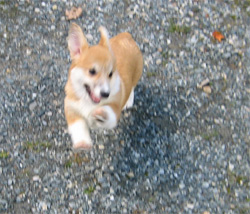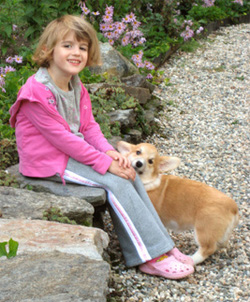 On September 4, 2007, I brought home a 16-week-old female Pembroke corgi pup. Those of you who routinely read these commentaries could very well be thinking, “I distinctly remember that woman swearing on a stack of religiously significant tomes that she would never get another corgi after Violet the WonderDog died.” And were you to think such thoughts, you needn’t wonder if your memory is failing you; your memory is fine. I did vow never to get another corgi because Violet was such a great dog that any subsequent corgi would surely suffer unfairly from comparison.
On September 4, 2007, I brought home a 16-week-old female Pembroke corgi pup. Those of you who routinely read these commentaries could very well be thinking, “I distinctly remember that woman swearing on a stack of religiously significant tomes that she would never get another corgi after Violet the WonderDog died.” And were you to think such thoughts, you needn’t wonder if your memory is failing you; your memory is fine. I did vow never to get another corgi because Violet was such a great dog that any subsequent corgi would surely suffer unfairly from comparison.
So what changed?
What changed is that there is no comparison. BeeBee was born brain-damaged. Although other conditions may reveal themselves over time, right now the following is known. She is completely deaf and has coordination problems, including limited control of her neck muscles, although this and her general coordination are improving. Her control over her tongue is also limited and she has such a pronounced overbite that it is difficult for her to pick up things. And she’s visually impaired.
Other than that, she’s a perfectly normal pup. Although I say that facetiously in the anatomical, but in the behavioral and bond sense and from BeeBee’s point of view it’s absolutely true. BeeBee does not perceive herself as abnormal in any way. Nor has the cat perceived her as abnormal in any way from the first day he met her. It took Frica, my shitzu mix a little longer, but still an amazingly short 3 days to figure out and accept BeeBee’s limitations, unique body language and vocalizations. And it only took that long because Fric was stung by a bee (ironically!) while making her first foray into serious outdoor play with BeeBee on the second day, and backed off to study her some more. My old hound, Watson, immediately donned his, “Oh, God, another pesky puppy to deal with” look, and alternates between sleeping and heaving sighs of resignation, periodically broken by a warning growl when the play gets too rambunctious.
 Although the resident quadrupeds got BeeBee sorted out very quickly and BeeBee thought she was fine from the get-go, the resident human has taken a lot longer, at least academically. By that, I mean that I had no trouble seeing her as normal from the first day because her personality (animal-ality?) made it impossible to consider her a victim or anything other than normal. She simply wouldn’t stand for that and appears to have little tolerance for those who would pity her or seek to limit her activities in any way. Except going up and down my steep, narrow stairs, but I consider that normal puppy good sense. But normal though she may be in her mind and my heart, the established mental circuitry for my veterinary, behavioral, and bond work, coupled with my philosophical desire to understand the why of things, has led me to at least try to learn more about how she perceives her world and relates to it.
Although the resident quadrupeds got BeeBee sorted out very quickly and BeeBee thought she was fine from the get-go, the resident human has taken a lot longer, at least academically. By that, I mean that I had no trouble seeing her as normal from the first day because her personality (animal-ality?) made it impossible to consider her a victim or anything other than normal. She simply wouldn’t stand for that and appears to have little tolerance for those who would pity her or seek to limit her activities in any way. Except going up and down my steep, narrow stairs, but I consider that normal puppy good sense. But normal though she may be in her mind and my heart, the established mental circuitry for my veterinary, behavioral, and bond work, coupled with my philosophical desire to understand the why of things, has led me to at least try to learn more about how she perceives her world and relates to it.
In this regard, I’ve had help from several sources I want to publicly thank. Veterinarians Rich Ford and Andrea Neiley, first for not saying “Are you out of your mind?!” when I got her and, second, for their insights into possible causes and prognosis. Janet Velenovsky at Premier Pet (www.premier.com) sent BeeBee a collection of toys that helped me determine BeeBee’s preferences and manipulative limitations, as well as helped overcome any hesitation Fric had regarding close-up play. BeeBee instantly gravitated toward the soft toys, most likely because these were the easiest for her to pick up. Once she accepted them and observed Fric’s interest in the other toys, she moved on to the harder textured interactive ones. All of the dogs get an interactive toy each morning, and her favorite is one that looks like a purple flying saucer because she can easily roll it, even with her overbite. Among the soft toys, one call the Wild Thing is a big hit, both for solo and group play. As in kids, play is a wonderful way for animals to develop strength, flexibility, and coordination and this collection has definitely advanced BeeBee in those areas.
Ken Clifton at PetSafe sent BeeBee a vibrating collar (link) that enabled me to start pinning down her visual problems. These turned out to be more extensive that I’d first suspected, but each day I learn a bit more. Mary Taylor, who works at the Monadnock Regional Humane Society in New Hampshire and has deaf dogs of her own, turned BeeBee over to me with a bag of semi-moist treats that I used to train Bee to the collar. Unfortunately, these were so tasty that all three dogs pursued me through the house when I had them, limiting training. To get around this, I took BeeBee outdoors by herself and she quickly learned that the vibration meant come. But unless I was within a specific distance of her, triggering the collar would just cause her to stand still and look around trying to find me. That told me that the collar works, but only when I’m close enough that she can see me and any hand signals.
 However, Bee and I only had one such training session because she quickly realized that the best way to ensure a reward is to stay as close to me as possible at all times. This resulted in my racing and leaping (with my bum knees) in a bizarre ballet, trying to simultaneously outrun and avoid stepping on an amazingly fast staggering dog so I could get far enough away from her to summon her with the collar. My failure to accomplish anything in these endeavors beyond awkward pirouettes and arabesques worthy of the dancing hippos in Fantasia has since caused me to resort to the same devious (and politically incorrect) trick Fric uses when Bee tires her out and she wants a break. First I wait until Bee is marginally distracted so I can put about 5′ between us. Then I bolt with much fanfare, causing her to dash madly after me, and fully lock onto my motion. Once she does that, I veer off suddenly, run for about 8′ and then freeze. She will immediately skid to a stop and look for me. Then I can step into her line of vision and orient her with the collar and a wave, although I admit that sometimes she’s well on her way toward me before I can summon her.
However, Bee and I only had one such training session because she quickly realized that the best way to ensure a reward is to stay as close to me as possible at all times. This resulted in my racing and leaping (with my bum knees) in a bizarre ballet, trying to simultaneously outrun and avoid stepping on an amazingly fast staggering dog so I could get far enough away from her to summon her with the collar. My failure to accomplish anything in these endeavors beyond awkward pirouettes and arabesques worthy of the dancing hippos in Fantasia has since caused me to resort to the same devious (and politically incorrect) trick Fric uses when Bee tires her out and she wants a break. First I wait until Bee is marginally distracted so I can put about 5′ between us. Then I bolt with much fanfare, causing her to dash madly after me, and fully lock onto my motion. Once she does that, I veer off suddenly, run for about 8′ and then freeze. She will immediately skid to a stop and look for me. Then I can step into her line of vision and orient her with the collar and a wave, although I admit that sometimes she’s well on her way toward me before I can summon her.
I’m learning so many odds and ends about perception—both human and canine—and the bond that I plan to give BeeBee her own blog category to ruminate about them. Currently, I am as confounded by all the conflicting human choices that resulted in her sleeping under my desk as I am by my attempts to understand her perceptual reality. I am equally confounded by the reality with its new perceptions that her limitations has created for me. I am torn between structuring her life and experience so that she’ll be as much like other dogs as possible—even though so far this doesn’t seem to be nearly the issue to her as it is to other people—versus allowing her to make the most of the unique physical and perceptual reality that’s hers alone. So many dog-related responsibilities and clichés to work through! So much wheat to sort from chaff!
For now, I take the same advice I give to clients to heart: whatever she experiences, it’s normal for her. What I need to learn in the days ahead is what’s normal for me relative to her and the two of us together in our shared environment.
If you have any comments regarding subject matter, favorite links, or anything you’d like to see discussed on or added to this site, please let me know at mm@mmilani.com.
So what changed?
What changed is that there is no comparison. BeeBee was born brain-damaged. Although other conditions may reveal themselves over time, right now the following is known. She is completely deaf and has coordination problems, including limited control of her neck muscles, although this and her general coordination are improving. Her control over her tongue is also limited and she has such a pronounced overbite that it is difficult for her to pick up things. And she’s visually impaired.
Other than that, she’s a perfectly normal pup. Although I say that facetiously in the anatomical, but in the behavioral and bond sense and from BeeBee’s point of view it’s absolutely true. BeeBee does not perceive herself as abnormal in any way. Nor has the cat perceived her as abnormal in any way from the first day he met her. It took Frica, my shitzu mix a little longer, but still an amazingly short 3 days to figure out and accept BeeBee’s limitations, unique body language and vocalizations. And it only took that long because Fric was stung by a bee (ironically!) while making her first foray into serious outdoor play with BeeBee on the second day, and backed off to study her some more. My old hound, Watson, immediately donned his, “Oh, God, another pesky puppy to deal with” look, and alternates between sleeping and heaving sighs of resignation, periodically broken by a warning growl when the play gets too rambunctious.
In this regard, I’ve had help from several sources I want to publicly thank. Veterinarians Rich Ford and Andrea Neiley, first for not saying “Are you out of your mind?!” when I got her and, second, for their insights into possible causes and prognosis. Janet Velenovsky at Premier Pet (www.premier.com) sent BeeBee a collection of toys that helped me determine BeeBee’s preferences and manipulative limitations, as well as helped overcome any hesitation Fric had regarding close-up play. BeeBee instantly gravitated toward the soft toys, most likely because these were the easiest for her to pick up. Once she accepted them and observed Fric’s interest in the other toys, she moved on to the harder textured interactive ones. All of the dogs get an interactive toy each morning, and her favorite is one that looks like a purple flying saucer because she can easily roll it, even with her overbite. Among the soft toys, one call the Wild Thing is a big hit, both for solo and group play. As in kids, play is a wonderful way for animals to develop strength, flexibility, and coordination and this collection has definitely advanced BeeBee in those areas.
Ken Clifton at PetSafe sent BeeBee a vibrating collar (link) that enabled me to start pinning down her visual problems. These turned out to be more extensive that I’d first suspected, but each day I learn a bit more. Mary Taylor, who works at the Monadnock Regional Humane Society in New Hampshire and has deaf dogs of her own, turned BeeBee over to me with a bag of semi-moist treats that I used to train Bee to the collar. Unfortunately, these were so tasty that all three dogs pursued me through the house when I had them, limiting training. To get around this, I took BeeBee outdoors by herself and she quickly learned that the vibration meant come. But unless I was within a specific distance of her, triggering the collar would just cause her to stand still and look around trying to find me. That told me that the collar works, but only when I’m close enough that she can see me and any hand signals.
I’m learning so many odds and ends about perception—both human and canine—and the bond that I plan to give BeeBee her own blog category to ruminate about them. Currently, I am as confounded by all the conflicting human choices that resulted in her sleeping under my desk as I am by my attempts to understand her perceptual reality. I am equally confounded by the reality with its new perceptions that her limitations has created for me. I am torn between structuring her life and experience so that she’ll be as much like other dogs as possible—even though so far this doesn’t seem to be nearly the issue to her as it is to other people—versus allowing her to make the most of the unique physical and perceptual reality that’s hers alone. So many dog-related responsibilities and clichés to work through! So much wheat to sort from chaff!
For now, I take the same advice I give to clients to heart: whatever she experiences, it’s normal for her. What I need to learn in the days ahead is what’s normal for me relative to her and the two of us together in our shared environment.
If you have any comments regarding subject matter, favorite links, or anything you’d like to see discussed on or added to this site, please let me know at mm@mmilani.com.